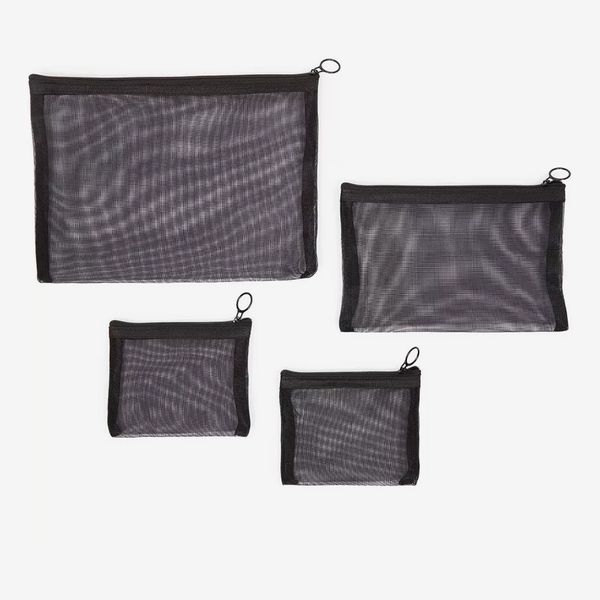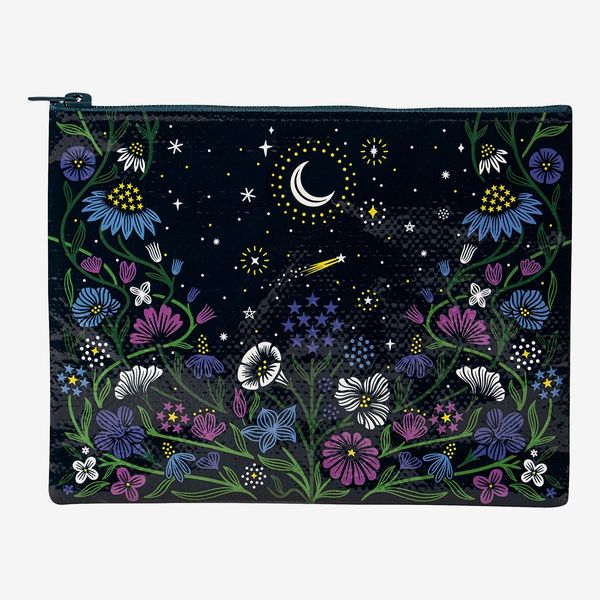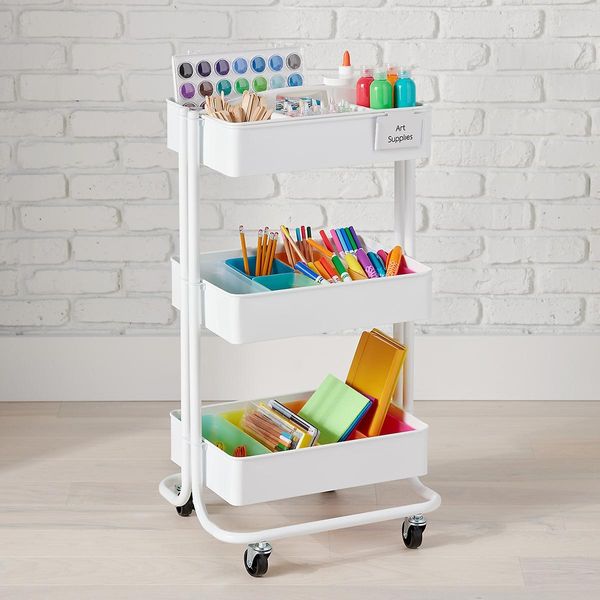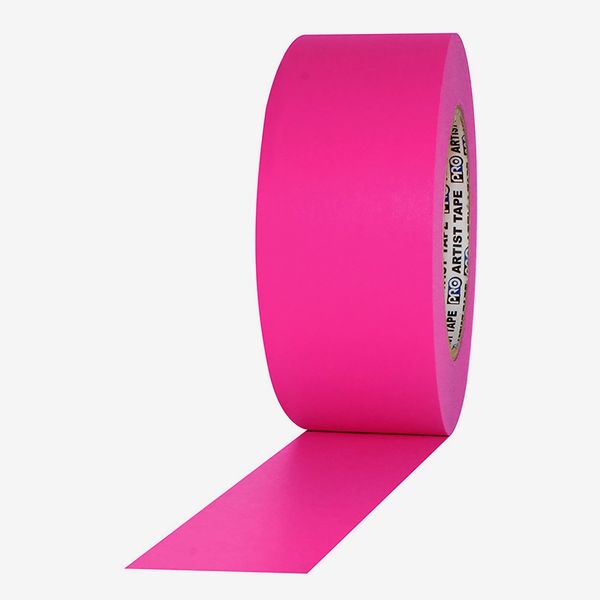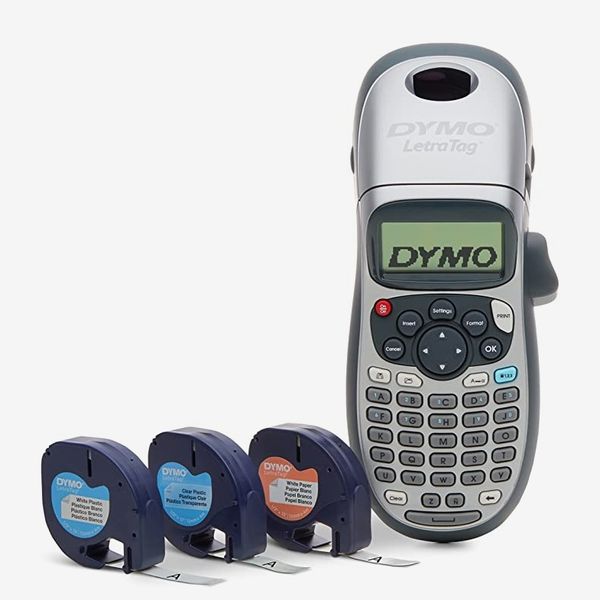
Managing kids’ arts-and-crafts supplies in a way that’s conducive to making — but doesn’t leave you with glitter mashed into the rug — requires creative solutions that are both functional and well designed. When my family moved into our Brooklyn apartment, we decided to dedicate a corner of our living room to what we call the Art Table. The table was made of a wooden Ikea countertop and mounted on metal-pipe legs that we could set at a kid-appropriate height for our then 4- and 6-year-olds. Our goal was twofold. First, to keep the kids’ Play-Doh, paint, sequins, drawings-in-progress, and art supplies off our dining space; second, to encourage them to make stuff by feeling like their supplies were accessible.
The challenge with arts-and-crafts supplies is that they range tremendously in size and volume, so the way you store sequins and googly eyes needs to be different from how you store your poster board. To find out how other parents rein in materials and preserve their kids’ masterpieces, I talked to a range of experts, from prop stylists to artists to a professional organizer, to learn which creative solutions they employ that work for both the kids and adults in the household.
“I’m a big believer in leaving art supplies out and in close reach to make it easier for my kids (and myself!) to make things when they’re bored,” says Erin Jang, a Brooklyn-based illustrator and designer who often collaborates with her 11- and 6-year-old boys. All of our experts emphasized that a good solution balances accessibility, organizational systems, and aesthetics — and accepting the unknown quantity of chaos that kids and their stuff can bring to a space. Here, what they recommend.
Storage and organization for supplies
Tova Weinstock, a professional organizer who runs a business called Tidy Tova, says “an art caddy is a must for every household and recommends the option from mDesign. This way, you can grab art supplies and set up your children anywhere — the kitchen table, the floor, a small kids’ table.” Many of our other experts reinforced the handiness of a portable caddy.
Jang’s favorite caddies are made by Liewood: “Their smaller one is just the right size for little kids to pick up and move around. I love the minimal design, and it comes in a handful of beautiful colors so you won’t mind having it out on the coffee table all the time.”
If you prefer a nonplastic version, Lexi Mainland, a writer, editor, and mom of two, recommends this woven seagrass caddy, which she notes “looks more decorative than plastic or metal and doesn’t scratch and discolor over time. My kids also cannot affix stickers to these, and I like that.”
For tinier trinkets and supplies, Japanese toolboxes are beautiful containers for collections and trinkets. “We have a small one filled with beads and jewelry-making supplies, but I’m on the hunt for something bigger to house my son’s growing gemstone collection,” says Mainland. Search “Japanese toolbox” on Amazon and prepare to marvel at the possibilities.
If you’re more of a pouch person than a caddy person, Yen Ha, an artist, architect, and mom of two, recommends this Glamlily set as a handy grab-and-go solution. “You can easily see which one has crayons or colored pencils, and they’re easy to grab and take with you to grandma’s for the weekend,” she explains.
Mainland uses waterproof zipper bags for artists for everything from stickers to origami, which helps condense supplies from their original packaging. The bags are indestructible, she notes, and come in a wide variety of shapes and sizes. “If we’re traveling or going out to a restaurant where my kids need to be neutralized for an hour, I’ll grab a couple of pouches and take them in my bag. At home, I wipe off the ketchup smears and keep them all in a big basket where the kids can easily see what’s in them.”
For durable pouches with more playful designs, Rion Nakaya, creator of The Kid Should See This — a site of smart, curated videos for kids — uses Blue Q’s zipper pouches and pencil cases, made from 95 percent postconsumer material: “I have about ten of them holding various items: seed packets, wax seal stamps, Tattly temporary tattoos, patches, sewing supplies, etc.”
Another system our experts used for organizing supplies by type is to employ a system of jars or cans, creating a veritable pantry of supplies at arm’s reach. You can usually repurpose any durable food jar — whether a mason jar, a washed-out glass Bonne Maman jam jar, or a durable cardboard Kroger’s Crispy Fried Onion canister — as recommended by designer and art director Abby Clawson Low, a mom of three boys based in Dallas, Texas. “I’ll usually cover the outside of the cardboard cylinder with color paper or something that looks bright and fun. They are great for storage and use — you can always see all of the pencil and marker tips of colors that are available, and they are easy for grab-and-go projects!” Jars, canisters, and caddies can live on a rolling cart and be pulled over to the project area whenever the mood strikes. Weinstock recommends the Art Supplies Cart from the Container Store.
Nakaya recommends the similar Råshult cart from Ikea. “Easy access, easy cleanup, easy to roll around, or just grab a can on the go,” Nakaya says. “The bottom shelves can also hold additional paper stacks or supplies in small bins and shoe boxes.“
For less frequently used supplies or the ones that are so messy you prefer your kids to only pull them out with real intention, our experts recommended several stackable larger box systems.
For a transparent option, Jang recommends the Container Store’s clear stacking shoe boxes.
Jang also likes these Cubbie Storage Tote Trays, which come in a rainbow of colors.
Low employs a combination of small and medium Kuggis bins from Ikea and puts them directly in drawers where the kids can either reach in or pull out the entire bin out for projects.
When you’ve started to accumulate multiple storage boxes, this is where having a labeling system can really come in handy and allow you to stack containers in tight spaces. Randi Brookman Harris, a prop stylist based in L.A., uses a fluorescent-red masking tape for all her labeling, now known as the family signature. “The roll lives on our fridge handle along with a sharpie on a string hung from the same spot, so it’s always at the ready. It’s great to make things look unified with the label if the vessels are disparate.” You can, of course, pick your own family’s signature color.
If you’d rather use a machine to do your labeling, Jang recommends a DYMO or Brother label-maker. “One habit I picked up from working on craft photo shoots at Martha Stewart is labeling and organizing art-supply bins with a sticker-label maker. It makes finding and organizing supplies so much easier.”
Artwork storage
Once your kids start making masterpieces, you’ll notice their creations accumulate very quickly. Whether it’s your emotional attachment or conviction they’re the next Monet that compels you to save their work, you’ll need a place to store their many works of art. Jang recommends this colorful and handy Poketo Pro Filer, which allows for different types of work in each of the slots. “My kids are constantly making drawings, collages, and cards, so I like having this giant accordion folder to store some of their work. There are 12 pockets inside the organizer in the prettiest colors.
For storing wooden puzzles, extra paper, and drying artwork, Low recommends Ikea’s letter tray, which is powder coated in matte white paint and lined with cork: “We use them in our office for sorting colored cardstock paper that we have on hand for the myriad kid projects. We also use the letter tray to store wooden puzzles. The trays come completely out so you can use it as a surface for the puzzle when you aren’t storing it away.”
For storing larger artworks and art supplies, Jang recommends utilizing the space under your sofa or a cabinet and recommends the Bay Isle Wicker Underbed Storage. “I have three giant underbed baskets that fit under our sofa. The dimensions are large enough to store bigger sheets of paper, a paper cutter, and other bulkier supplies yet shorter in height than most underbed storage bins — so they can be tucked away easily under a lower sectional sofa.”
Mainland recommends the wood rolling drawer from Plan Toys, which can be used to keep both artwork and toys in a safe and tidy spot (under a sofa or bed, for example, depending on their height) and looks “like a Donald Judd creation for the under-10 set.”
The Strategist is designed to surface the most useful, expert recommendations for things to buy across the vast e-commerce landscape. Some of our latest conquests include the best acne treatments, rolling luggage, pillows for side sleepers, natural anxiety remedies, and bath towels. We update links when possible, but note that deals can expire and all prices are subject to change.




